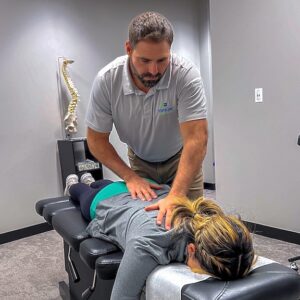If you’ve ever experienced the sharp, shooting pain that radiates from your lower back down through your legs, you know just how debilitating sciatica can be. Sciatica is a common condition that affects millions of people, and it can significantly impact your daily life. Fortunately, there’s hope for relief, and it might be closer than you think. In this blog post, we will explore how chiropractic care can help alleviate the pain and discomfort associated with sciatica. So, if you’re searching for a “chiropractor near me” or simply interested in learning more about chiropractic care, keep reading.
Understanding Sciatica: The Basics
Before we delve into how chiropractic care can be a solution, let’s start by understanding what sciatica is. Sciatica is not a condition in itself, but rather a symptom of an underlying issue. It occurs when the sciatic nerve, which runs from your lower back through your hips and down each leg, becomes irritated or compressed. This irritation can result from various factors, such as a herniated disc, spinal stenosis, or even muscle imbalances. The most common symptom of sciatica is the shooting pain mentioned earlier, but it can also include tingling, numbness, or weakness in the affected leg.
Why Choose Chiropractic Care for Sciatica Relief?
When it comes to managing sciatica, chiropractic care has gained popularity as a non-invasive, drug-free, and effective approach. Chiropractors are healthcare professionals who specialize in diagnosing and treating musculoskeletal conditions, including those that lead to sciatic pain. Here’s how they can help:
Spinal Adjustments Address the Root Cause:
Chiropractic care’s cornerstone is addressing the root cause of your sciatica. Many times, the underlying issue can be traced back to the alignment of your spine. When spinal misalignments, also known as subluxations, occur, they can exert pressure on the sciatic nerve, leading to pain and discomfort. Chiropractic adjustments are precisely designed to correct these misalignments. By realigning the spine, chiropractors relieve the pressure on the nerve, facilitating its proper function. As a result, this can alleviate the pain and discomfort associated with sciatica, offering a long-lasting solution rather than merely masking the symptoms.
Customized Treatment Plans for Individual Needs:
Chiropractic care is far from a one-size-fits-all approach. Instead, it focuses on your unique condition. Chiropractors begin the process with a comprehensive assessment that may involve X-rays to precisely locate the origin of your sciatic pain. Armed with this valuable information, they can craft a personalized treatment plan tailored to your specific needs. This personalized approach ensures that the care you receive is precisely targeted, addressing the factors contributing to your sciatica, and maximizing the effectiveness of the treatment.
Non-Invasive and Drug-Free Approach:
Chiropractic care is notably non-invasive, meaning it doesn’t necessitate surgical intervention. For many, this is an appealing alternative to invasive procedures, which can be accompanied by risks and prolonged recovery periods. Additionally, chiropractic care is a drug-free solution. This is advantageous for those who prefer to avoid medications and their potential side effects. Rather than masking the pain with drugs, chiropractors aim to correct the underlying issue causing the pain, thereby promoting natural healing and long-term relief.
Holistic Healthcare Perspective:
Chiropractors adopt a holistic approach to healthcare, acknowledging not just the physical aspects of your condition but your overall well-being. In addition to spinal adjustments, they may incorporate a variety of complementary therapies and lifestyle recommendations to enhance your recovery. This can include exercises to strengthen supporting muscles, dietary advice to reduce inflammation and promote healing, and ergonomic suggestions to prevent future episodes of sciatica. The holistic approach means that your chiropractor addresses not just the symptoms but the factors contributing to your sciatic pain.
Comprehensive Pain Management:
Chiropractors employ multiple techniques to effectively manage pain. In addition to spinal adjustments, they may utilize soft tissue therapy, targeting muscle tension and knots that contribute to your discomfort. Application of heat or ice, electrical stimulation, and ultrasound therapy are additional methods used to reduce inflammation and alleviate pain. By addressing pain from multiple angles, chiropractic care offers a multi-faceted approach to pain management, resulting in comprehensive relief.
Improved Functionality and Mobility:
As spinal misalignments are corrected, many patients report not only pain relief but also significant improvements in their range of motion and overall functionality. This aspect is particularly beneficial for individuals whose sciatica has hindered their daily activities. Chiropractic care aims to restore your body’s natural functionality, allowing you to move more freely, comfortably, and without restrictions.
Preventative Benefits for Long-Term Health:
Chiropractic care is not limited to alleviating existing pain; it also concentrates on preventing future sciatic episodes. By addressing the root causes of sciatica and providing guidance on maintaining a healthy spine and lifestyle, chiropractors help you reduce the risk of recurring issues. This preventive perspective is an essential element of chiropractic care, ensuring that the benefits extend far beyond immediate relief to long-term health and well-being.
Enhanced Nerve Function:
Chiropractic care not only relieves the pressure on the sciatic nerve but also works to improve its overall function. By promoting better nerve communication, chiropractors aim to optimize the transmission of signals between your brain and the affected areas, contributing to quicker recovery and reduced pain. This focus on nerve function can lead to more comprehensive and longer-lasting relief from sciatica.
Minimized Risk of Recurrence:
Chiropractic care places a strong emphasis on addressing the underlying causes of sciatica, which can often be attributed to lifestyle factors, poor posture, or misaligned spine. By identifying and correcting these root issues, chiropractors help minimize the risk of sciatic pain recurring in the future. This approach is especially valuable for those who want a sustainable solution to their discomfort, allowing them to enjoy a pain-free life.
Non-Pharmacological and Non-Surgical Alternative:
Chiropractic care provides a safe, non-pharmacological, and non-surgical alternative to manage and treat sciatica. This is a particularly attractive option for individuals who wish to avoid the potential side effects of medication or the risks associated with surgical interventions. Chiropractic care’s non-invasive nature and drug-free approach align with the preferences of many patients who seek a natural path to recovery without the need for invasive procedures or pharmaceuticals.
What to Expect during Chiropractic Treatment
Now that you have a better understanding of why chiropractic care is a viable option for sciatica relief, let’s explore what you can expect when you visit a chiropractor near you for treatment.
Initial Assessment:
Your first visit to a chiropractor will typically begin with an initial assessment. During this phase, the chiropractor aims to gather essential information about your medical history, lifestyle, and the specific details of your sciatica. They will ask you questions about your pain, its duration, and any activities or movements that exacerbate or alleviate the discomfort. Providing accurate and detailed information is crucial for the chiropractor to make an accurate diagnosis.
Physical Examination:
After discussing your medical history, the chiropractor will perform a thorough physical examination. This may involve checking your posture, gait, and the range of motion in your affected leg. The chiropractor will also conduct specific orthopedic and neurological tests to assess your muscle strength, reflexes, and sensory perception.
Diagnostic Tests:
In some cases, your chiropractor may recommend diagnostic tests, such as X-rays or other imaging studies, to get a closer look at your spine and identify any structural issues. These tests can help confirm the diagnosis and provide a clear picture of the condition of your spine.
Treatment Plan Development:
Once the chiropractor has gathered all the necessary information from the assessment, examination, and any diagnostic tests, they will develop a personalized treatment plan tailored to your needs. This plan will outline the recommended course of action, including the frequency of visits, the types of adjustments or therapies to be used, and the expected duration of treatment. It’s crucial to discuss this plan with your chiropractor and ask any questions to ensure you’re comfortable with the proposed approach.
Spinal Adjustments:
The hallmark of chiropractic care is the spinal adjustment. Chiropractors use their hands or specialized instruments to apply controlled, precise force to specific areas of your spine. These adjustments aim to correct misalignments or subluxations in the vertebrae that may be contributing to your sciatic pain. The adjustments are typically gentle and should not be painful. They are designed to restore proper spinal alignment and alleviate pressure on the sciatic nerve.
Complementary Therapies:
In addition to spinal adjustments, your chiropractor may incorporate complementary therapies to enhance the effectiveness of your treatment. These therapies might include:
Heat or Ice Application: The application of heat or cold packs can help reduce inflammation and provide relief from pain.
Electrical Stimulation: This involves using mild electrical currents to stimulate muscles, reduce muscle spasms, and promote healing.
Ultrasound: Ultrasound therapy utilizes high-frequency sound waves to promote tissue healing and reduce pain.
At-Home Exercises and Self-Care:
Your chiropractor may provide you with specific exercises and self-care instructions to follow at home. These exercises are designed to complement the in-office treatments and help you maintain and improve your spinal health. They may include stretching, strengthening, and posture-improvement exercises.
Follow-Up Visits:
Chiropractic care typically involves a series of follow-up visits. The frequency of these visits will depend on your specific condition and treatment plan. During these appointments, the chiropractor will monitor your progress, make any necessary adjustments to your treatment plan, and assess how you’re responding to the care.
Sciatica can be a painful and limiting condition, but you don’t have to suffer in silence. Chiropractic care offers a natural, drug-free, and personalized approach to managing and alleviating sciatic pain. By addressing the root causes of your discomfort and providing tailored treatment plans, chiropractors can help you regain your mobility and improve your quality of life. If you’re searching for a solution to your sciatica, consider reaching out to a chiropractor near you and taking the first step towards a pain-free future.
Why Choose Us?
At Evolve Chiropractic of Libertyville, we take pride in being the go-to destination for exceptional chiropractic care. Our dedicated team of professionals is committed to helping you experience the benefits of a healthy, pain-free life. With a focus on holistic well-being, we offer a range of chiropractic services tailored to your specific needs, whether you’re seeking relief from chronic pain, enhancing your athletic performance, or simply improving your overall quality of life. Our Libertyville-based facility is designed to provide a welcoming and comfortable environment where you can embark on your journey to better health. Visit Evolve Chiropractic to experience the best in chiropractic care, where our skilled practitioners are passionate about helping you evolve towards a healthier, happier you.
Evolve Chiropractic of Libertyville
755 S Milwaukee Ave Ste 127, Libertyville, IL 60048
(847) 984-2965





